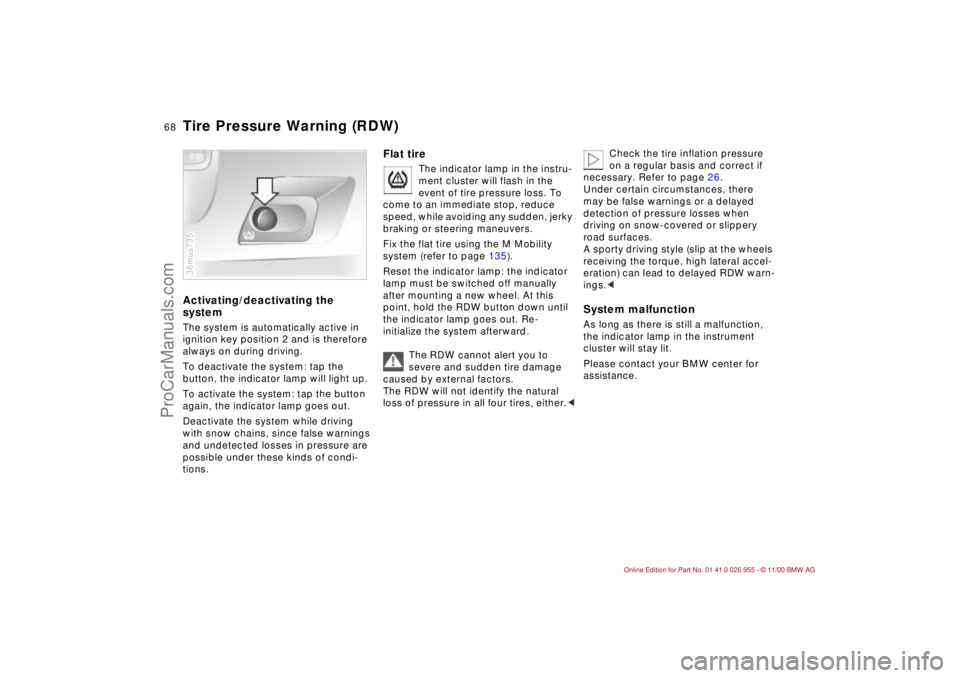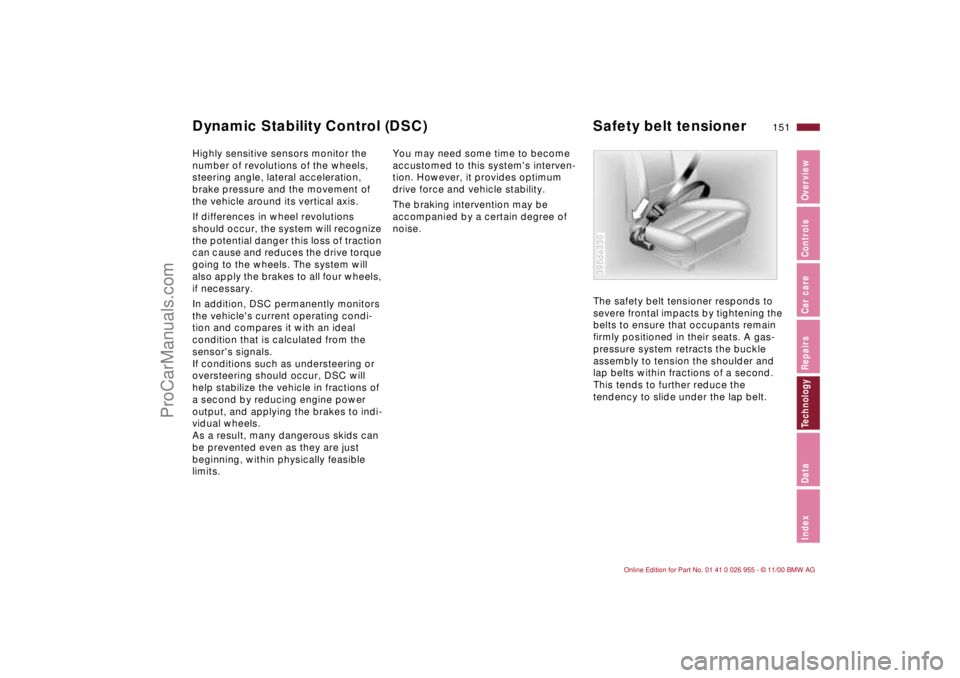Page 68 of 171

68n
Tire Pressure Warning (RDW)Activating/deactivating the
systemThe system is automatically active in
ignition key position 2 and is therefore
always on during driving.
To deactivate the system: tap the
button, the indicator lamp will light up.
To activate the system: tap the button
again, the indicator lamp goes out.
Deactivate the system while driving
with snow chains, since false warnings
and undetected losses in pressure are
possible under these kinds of condi-
tions. 36mus735
Flat tire
The indicator lamp in the instru-
ment cluster will flash in the
event of tire pressure loss. To
come to an immediate stop, reduce
speed, while avoiding any sudden, jerky
braking or steering maneuvers.
Fix the flat tire using the M Mobility
system (refer to page 135).
Reset the indicator lamp: the indicator
lamp must be switched off manually
after mounting a new wheel. At this
point, hold the RDW button down until
the indicator lamp goes out. Re-
initialize the system afterward.
The RDW cannot alert you to
severe and sudden tire damage
caused by external factors.
The RDW will not identify the natural
loss of pressure in all four tires, either.<
Check the tire inflation pressure
on a regular basis and correct if
necessary. Refer to page 26.
Under certain circumstances, there
may be false warnings or a delayed
detection of pressure losses when
driving on snow-covered or slippery
road surfaces.
A sporty driving style (slip at the wheels
receiving the torque, high lateral accel-
eration) can lead to delayed RDW warn-
ings.<
System malfunctionAs long as there is still a malfunction,
the indicator lamp in the instrument
cluster will stay lit.
Please contact your BMW center for
assistance.
ProCarManuals.com
Page 151 of 171

151n
IndexDataTechnologyRepairsCar careControlsOverview
Highly sensitive sensors monitor the
number of revolutions of the wheels,
steering angle, lateral acceleration,
brake pressure and the movement of
the vehicle around its vertical axis.
If differences in wheel revolutions
should occur, the system will recognize
the potential danger this loss of traction
can cause and reduces the drive torque
going to the wheels. The system will
also apply the brakes to all four wheels,
if necessary.
In addition, DSC permanently monitors
the vehicle's current operating condi-
tion and compares it with an ideal
condition that is calculated from the
sensor's signals.
If conditions such as understeering or
oversteering should occur, DSC will
help stabilize the vehicle in fractions of
a second by reducing engine power
output, and applying the brakes to indi-
vidual wheels.
As a result, many dangerous skids can
be prevented even as they are just
beginning, within physically feasible
limits.You may need some time to become
accustomed to this system's interven-
tion. However, it provides optimum
drive force and vehicle stability.
The braking intervention may be
accompanied by a certain degree of
noise.
The safety belt tensioner responds to
severe frontal impacts by tightening the
belts to ensure that occupants remain
firmly positioned in their seats. A gas-
pressure system retracts the buckle
assembly to tension the shoulder and
lap belts within fractions of a second.
This tends to further reduce the
tendency to slide under the lap belt.
390de330
Dynamic Stability Control (DSC) Safety belt tensioner
ProCarManuals.com
Page 156 of 171
156n
M roadster, M coupe
Displacement
Number of cylinderscu in (cmm) 198.1 (3,246)
6
Maximum power output
at engine speedhp
rpm315
7,400
Maximum torqueat engine speedlb-ft (Nm)
rpm251 (340)
4,900
Compression ratioe 11.5
Stroke
Borein (mm)
in (mm)3.58 (91.0)
3.43 (87.0)
Fuel-injection system Digital-electronic engine management systemEngine specifications
ProCarManuals.com
Page 168 of 171

Everything from A to ZStarting problems
56, 88, 144, 145
Starting the engine56
Steering94
Steering wheel lock55
Storage boxes78
Storage trays78
Storing the vehicle123
Summer tires101
Sunroof36
Switching off the engine57
Symbols4, 140TTachometer62
Tail lamp assembly, bulb
replacement131t
Tail lamps131
bulb replacement131t
Tank capacity159
Technical Data155
Technical
modifications6, 124
Telephone, refer to the
separate Owner's Manual
Temperature display
engine coolant63
Temperature layering75
Tire condition98
Tire damage98t
Tire inflation
pressures26t, 98Tire Quality Grading99
Tire replacement99, 100
Tire rotation between front
and rear100
Tire specifications103
Tire tread98
Tires, identification101
Tools128t
Torque156
Tow fittings145t
Towing the vehicle145t
Track width157
Traction Control System,
refer to ASC+T/DSC
Transmission58
Tread depth, tires98
Trip odometer62
Turn signals23, 58
bulb replace-
ment130t, 131t
Turning circle157
Two-way radios95
UUniform Tire Quality
Grading99
Upholstery care121
Use of antifreeze112t
Used batteries141t
VVacuum cleaner,
connecting80
Valve caps101
Vanity mirrors48
Vehicle battery140, 160
Vehicle care
exterior115
interior120
Vehicle Identification
Number113
Vehicle immobilizer31
Vehicle storage123
Velour care121
Ventilation72
outlets72
Ventilation, draft-free75
Vents72
Vinyl upholstery, care120
Viscosity110WWarm feet – cool head75
Warning lamps20
Warning triangle24
Warranty and Service Guide
Booklet (Canadian
models)115
Washer fluid, adding108t
Washer nozzles,
adjusting108tWasher reservoir,
filling108t
Washers, headlamp60
Washing your vehicle115
Weights158
Wheelbase157
Wheels and tires101
Width157
Windows, convenience
closing mode32
Windshield washer108
filling reservoir108t
nozzles108
Windshield wipers59
blade replacement128t
Winter driving93
Winter tires102
Wiper blade
replacement128t
Wiper/Washer system59
Wipers59
Working in the engine
compartment104t
ProCarManuals.com